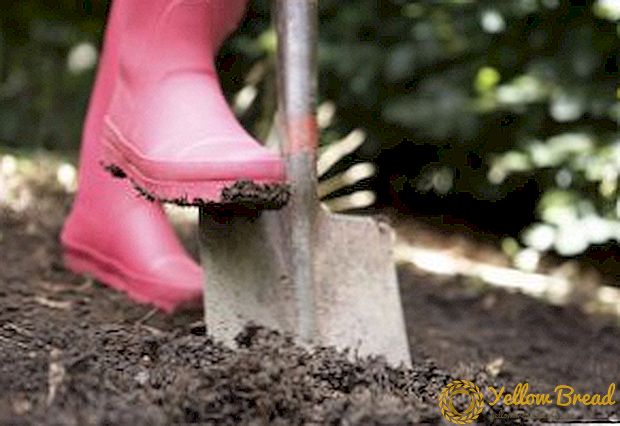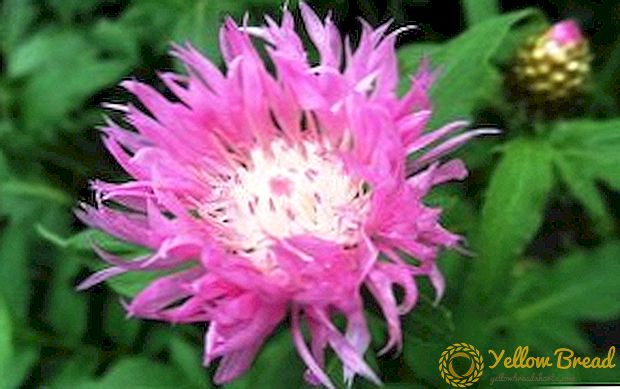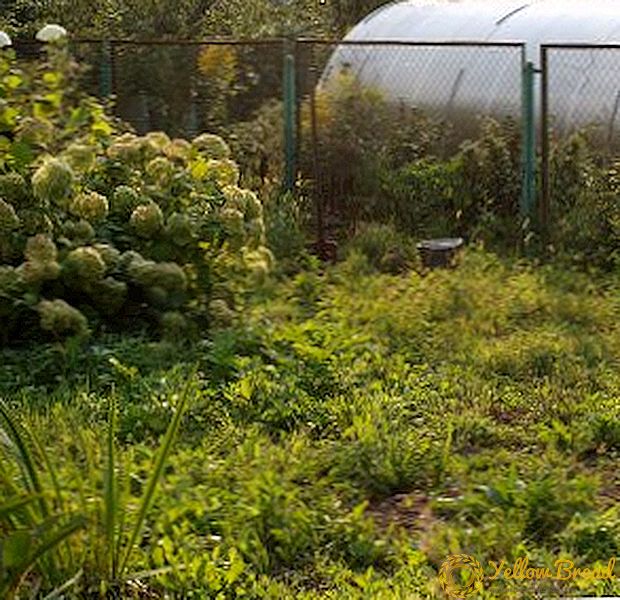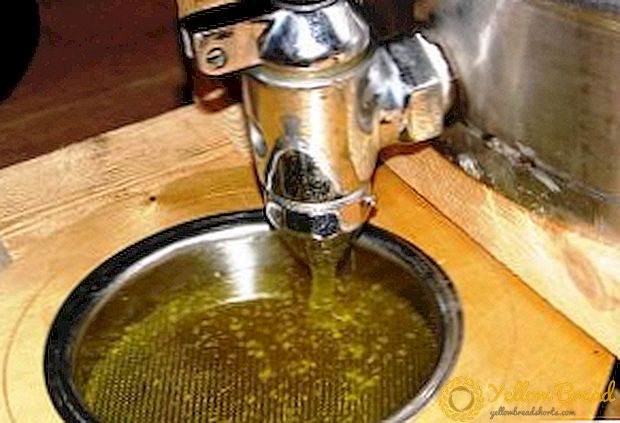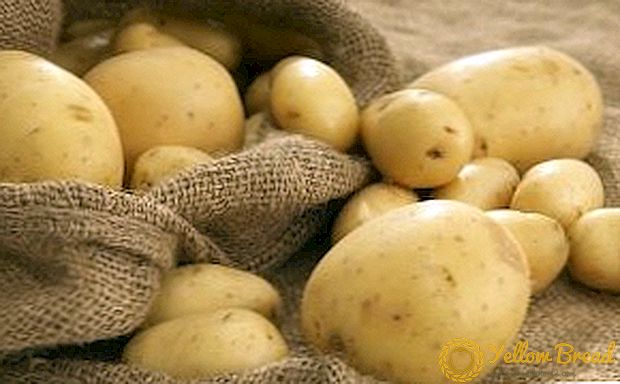
What is the most common vegetable on our plots? Carrot, onion, cabbage? No, potatoes.
This root crop has long become for us the same level as wheat, and therefore it can rightly be considered the "second bread".
In the 16th century, potatoes appeared in the ranges of Western Europe.
It was from that time that the potatoes began to spread farther and farther to the east.
And, as is now clear, he sat down in our gardens firmly and indestructibly.
But still, not every variety will take root on our site, so you should choose them carefully.
A list of the best varieties of potatoes has been prepared for you, which will become an indispensable tip for you before the start of the new agricultural season.
Variety "Impala"

The homeland of this variety is the Netherlands.
Despite the foreign origin, this potato able to grow in any climateeven the worst.
It refers to early varieties of potatoes, as the tubers gain enough weight to collect after 50 days after germination.
The bush of this variety is rather high (on average, 70 - 75 cm), upright, starts up 4 to 5 stems, forms white flowers.
Tubers are oval-shaped, yellow-skinned, with small eyes scattered on them.The flesh is light yellow in color, with an average starch content (15%), this variety is one of the best in taste.
One potato of this variety can gain weight from 90 to 150 g, and such tubers from one bush can be obtained from 16 to 21. This variety high cancer resistance, potato nematode, viruses A and Yn. But at the same time, indicators of resistance to late blight of tops and tubers, scab and leaf curling virus are average.
In the southern region, gardeners harvest 2 times per season. The yield is 18 - 36 tons per 1 hectare of land. The scope of use of this potato is very wide, cooked potatoes do not darken.
Planting material can be germinated previously before planting, but cold potatoes that you have just taken from storage can also be instilled into dropping. But the ground must be well warmed up so that the planting material begins to grow.
It is not advisable to break the young shoots on potatoes. Planting should be carried out according to the scheme - 30 cm between adjacent tubers, 65 cm between adjacent rows. The beginning of May is considered to be the best time for planting potatoes, since after such planting shoots will appear at the end of the month.
Caring for potatoes is loosening the soil, watering the bushes and fertilizing. This grade demanding on the amount of nitrogen in the soiltherefore, during the preparation of the site in the fall, the amount of nitrogen fertilizers should be reduced.
The first cultivation of the soil should take place 5 - 6 days after planting. After loosening the ground is necessary when a crust forms on the surface of the ground.
Spud the bushes is necessary if it is hot outside, and there is no opportunity to water the garden. If the tops of the potatoes have lost elasticity, then you need to water the bushes, and not less than 50 liters of water per 1 square meter.
Fertilizers should be applied according to soil fertility indicators. The total number of dressings should not exceed 3.
Sort "Felox"

This variety was bred by German breeders.
Early ripe potatoes (65 - 70 days) of this variety fall under the category of varieties of table purpose, have excellent taste and the optimal amount of starch in tubers.
The plants of this potato are erect, of medium height, with red-purple flowers. The leaves are dark green, medium size, with a glossy surface.The potatoes are oblong-oval in shape, with yellow skin, covered with eyes, and light yellow flesh.
When cutting potatoes, the pulp does not darken. On average, a good tuber weighs 90 - 115 g, but sometimes a potato can weigh 200 g.
On one plant can form from 19 to 25 tubers. The yield is very good, from a hectare of land you can get 550 - 650 centners of potatoes.
This variety has innate immunity to cancer and the potato nematode. Also, plants of this potato are not afraid of elevated temperatures. Indicators of resistance to late blight, various viruses and silver scab are quite low.
This potato can be stored for a long time., more than 90% of the crop survive after winter.
The question of the preliminary preparation of planting material is up to you. Before planting, the ground should heat up normally, but in the case of this variety it will begin to germinate at a temperature of + 2 C.
If the potatoes sprouted during storage, then these small shoots are not advisable to break off before or during planting. The landing pattern is standard 30x60-65 cm. It is better to plan your landing in May.
There are no special requirements for the care of this variety of potatoes.In hot summer, the ground needs to be watered with plenty of water, provided that there is very little rainfall during the month.
It is necessary to loosen the ground when it is dry, otherwise a thick crust forms on the surface that will not allow air to flow to the tubers.
We also need preventive and curative treatments against pests and diseases. Feed for potatoes are not needed, there is a soil quite fertile. Otherwise, no more than three times per season can be fertilized.
Grade "Nevsky"

Medium early potatoes of domestic breeding with a ripening period of 80 - 90 days. The shrubs are low, compact, with a large number of leaves, let a lot of lateral shoots, flowers forms white.
Tubers are oval, with light yellow skin, small, pink eyes and cream-colored flesh. The mass of a healthy, mature tuber reaches 90 - 130 g.
On one plant such potatoes are formed from 9 to 15 pieces. Up to 1.5 kg of fruits can be obtained from a bush.
The yield of this variety is very high - 38 - 50 tons of potatoes can be harvested per hectare.
This potato can be easily washed and peeled, perfect for making salads and soups. It is not advisable to make mashed potatoes of this variety and fry these root vegetables.
As for sustainability, cancer, rhizoctoniosis, alternarioz and black leg will not damage this variety.
The average resistance is observed to viruses, fitoftor and scab. Also, for this variety, high temperatures and an excess of moisture in the soil are not terrible. Stored well, but germinates at elevated temperatures.
Before landing you need be sure to warm the potatoes, as this variety is sensitive to the temperature of the soil and the condition of the planting material. Breaking sprouts on tubers is not desirable, since sensitivity to this procedure is increased in potatoes of this variety. Scheme and landing time usual.
It is important to maintain soil moisture during the tuber formation period. This procedure is necessary so that the scab does not damage the young plants. Already grown bushes will only need to loosen and process, since even a lack of moisture and high temperatures will not harm this potato.
Grade "Condor"

Variety of Dutch breeding. It is considered to be medium-term, since 70 to 90 days pass from the moment of emergence of the seedlings until the tubers reach maturity.
Appointment of this potato table. Bushes are upright, rather tall, with dark red-purple flowers.The fruits are elongated, oval-shaped, weighing 90 - 180 g, with red skin and medium-depth eyes.
The flesh is light yellow, with a percentage of starch of 9 - 14%. The taste is estimated as above average, which makes it possible to grow this potato not only for personal use, but also for subsequent sale.
Also indicators of yield in 18 - 36 kg of fruit from 10 sq. M. promote the idea of growing for commerce. This variety is resistant to the lack of moisture and cancer, but viruses, scab and late blight can worsen the condition of plants and root crops. One of the values of this potato is considered to be an excellent appearance, which increases its commercial quality.
It is best to grow this variety after perennial grasses, leguminous plants and winter crops. Tubers can not be prepared for planting in advance, but it is desirable to still get the potatoes from the cellar in advance and leave for a while in the sun. The landing pattern is normal, the depth should be 8 - 10 cm. It is better to land in May.
To ensure the normal growth of bushes of this variety of potatoes, it is important to constantly loosen the soil and remove the weeds that form in planting.It is not necessary to water this potato additionally, natural precipitation will be enough. You can also treat bushes with drugs against diseases, but not too often.
Sort "Slavyanka"

Mid-season variety of Ukrainian selection. The ripening period is delayed for 125 - 140 days. The plants are half-deciduous, not very tall.
The number of stems is not very large, but they are very branched. The leaves are dark green, the flowers are red-purple. On the peel there are a small number of eyes. Pulp cream color. The weight of a mature tuber can be 90 - 180 g.
Tubers are very large, oblong, oval-shaped, pink-purple. The taste is excellent, the percentage of starch is 12 - 13%. It can be stored for a long time, but mechanical damage should not be allowed.
Varietal resistant to cancer, nematode, as well as to wrinkled and banded mosaic, to the twisting of leaves. The yield per hectare may be more than 700 centners of potatoes. This variety is not picky about weather conditions and types of soil.
Planting material can not be prepared in advance, but dripping right after you get the potatoes from the cellar. The landing pattern, depth and landing time are maintained.During autumn soil preparation, a lot of fertilizer should be applied if the land is not fertile, as this variety develops very quickly.
As necessary procedures that need to be carried out with this potato are feeding and processing with preparations against diseases of various types. Fertilizing is necessary when you notice that the plants do not develop very strongly. Without additional feedings you are unlikely to get the expected yield, and its quality will be below average.
Variety "Zekura"

This potato variety was bred in Germany, but this did not prevent it from settling down and producing stable yields in the climatic conditions of Eastern Europe.
The bushes of this potato are upright, of medium height, not particularly sprawling, with inflorescences of purple color. The tubers of this variety are elongated, oval, with yellow skin, on which small eyes are scattered, the surface is smooth.
The flesh is colored yellow, the starch content is 13–19%. In terms of ripening is medium-term, as it forms mature fruits for 90 - 100 days from the moment of germination of the planted tubers.
Weight tuber technical maturity reaches to 100 - 200 grams, and 12-15 such tubers form in one plant. In general, about 50 tons of potatoes can be harvested per hectare of land with good climatic conditions and high soil fertility.
Scientists have instilled in this class immunity to almost all diseases of potatoes. It can be grown even in the soil with an increased amount of moisture. Can be stored for a long time without any special losses.
It is necessary to plant these potatoes in May according to the usual scheme to a depth of 8 cm. The unheated and heated tubers in the sun will take root equally, so you should not bother with preparing these potatoes for planting.
This variety can not be watered, as it is enough drought tolerant and, in general, not particularly whimsical in care. It is necessary to remove the weeds that form around young plants, and also to cultivate the soil after it rains.
The question of choosing a potato variety is quite solvable. It is enough to take into account the climatic features of the region and the level of soil fertility, so that the selected variety will give a good harvest.

